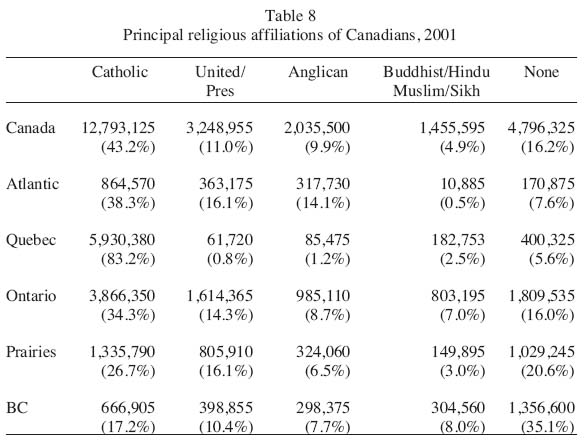A British Columbian View of Regions
Jean BarmanUniversity of British Columbia
1 GENERAL AGREEMENT EXISTS that Canada has become – and perhaps always was – divided into regions. Even the most cursory search of the World Wide Web indicates a commonplace reliance on regions, be it by business, federal bodies or cultural and educational organizations. Moving from east to west there is, in the most usual configuration, Atlantic Canada, Quebec, Ontario, the Prairies and British Columbia, with the far North variously added into the five regions. The province of British Columbia (BC) has sometimes been folded into what is termed "western Canada", often by persons from the Prairies seeking to expand westward,1 but for all intents and purposes stands apart as a region on its own.
2 If we are, then, a country of regions, what should we make of them? The Oxford English Dictionary gives two quite different definitions. The first defines regions as "areas of a country having definable characteristics but not always fixed boundaries" while the second defines regions as "the parts of a country outside the capital". As a historian of British Columbia who lives and writes in the region, I find both definitions attractive, but I also want to propose a third, which is to see regions relationally. Three research projects have turned my attention to the ways in which the attributes defining BC result from interaction with other regions as opposed to being distinctive provincial attributes or a consequence of BC rubbing up against the political and/or economic centre of Canada.
3 In this essay, I draw primarily on demographic data to re-imagine regions from a British Columbian perspective. I first look briefly at how British Columbia fits the two dictionary definitions and then examine British Columbia's interaction with two other regions, the Maritimes and the Prairies, as revealed through my research. Third, I use the 2001 census to extend my focus to regions in Canada more generally.
British Columbia and the dictionary definitions of region
4 The two Oxford English Dictionary definitions of regions might have been written for British Columbia. Both our geography and our human history encourage a sense of autonomy. We are enclosed within mountains on the east, water and then Asia on the west, and the United States on the north and south. Our landscape is unlike any other in Canada, as glimpsed by artist Emily Carr about her native province: "There is something bigger than fact: the underlying spirit, all it stands for, the mood, the vastness, the wildness, the Western breath of go-to-the-devil-if-you-don't-like-it, the eternal big spaceness of it. Oh the West! I'm of it and I love it".2 BC's geography, long viewed from the perspective of resource exploitation, is today more often couched in environmental and ecological terms.
5 Our human history builds on our geography. Colonialism came later to British Columbia than to any other region in Canada except the far North. It was only in the late-18th century that outsiders turned their attention to the northwest corner of North America. Not until the middle of the next century did a fairly benign fur trade, so far as Aboriginal peoples were concerned, give way to settlement. It was Great Britain that took charge, creating the colony of Vancouver Island in 1849 and the mainland colony of British Columbia in 1858. The two were joined in 1866 into a single British colony of British Columbia, which five years later acquired provincial status on joining the Canadian Confederation.
6 Once outsiders began to arrive, they did so in growing numbers. British Columbia has since then, as Table 1 and Table 2 show, outdistanced every other region in Canada demographically. From 1871 to 2001 the population grew 100 times, from 1901 to 2001 it grew more than 20 times and from 1951 to 2001 it grew over 3.5 times. The closest comparison from 1901 is with the Prairies, whose population expanded 12 times compared with BC's 20 times and, from 1951 to 2001, with Ontario whose population grew 2.5 times compared with BC's 3.5 times.
Table 1. Population growth between regions, 1871-2001
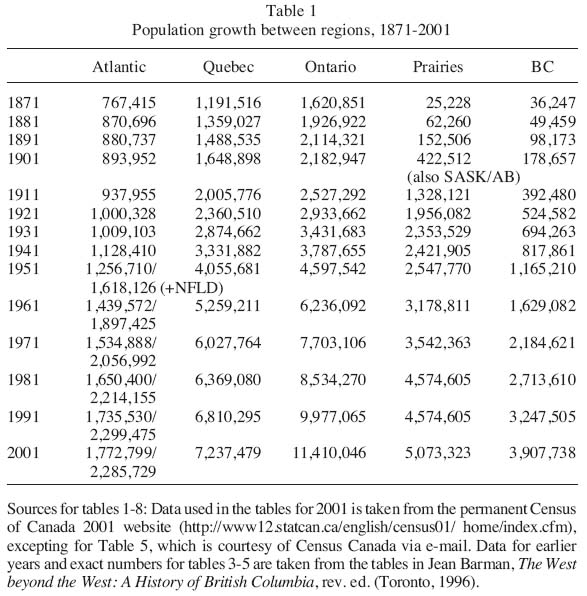
Display large image of Table 1
Table 2. Population growth within regions, 1871-2001
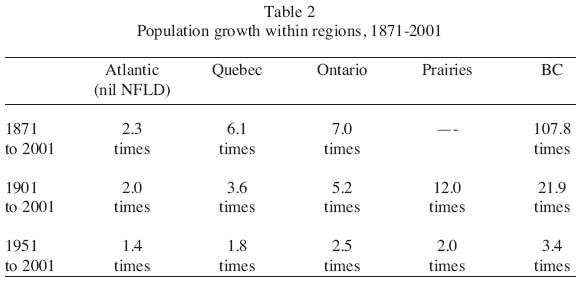
Display large image of Table 2
7 Newcomers swamped British Columbia's Aboriginal peoples, both numerically and in terms of the dispossession of their lands. Disease cut the total Aboriginal population to 25,000 by the time of BC's entry in Confederation and to just 20,000 at their nadir in 1911. By then Aboriginal peoples accounted for just 1 in 20 British Columbians, a proportion that sank further to 1 in 40 before slowly creeping upward toward 1 in 20 to 25 in 2001.3 The speed and disregard with which the Indigenous population was swept aside meant treaties were negotiated only in small parts of the region.
8 The province's British ethos emanating from the one-time colonial status was, as Table 3 summarizes, reinforced by the national immigration campaign of the early-20th century. The proportion arriving in British Columbia from Great Britain was, as Table 4 shows, far greater than the proportion arriving in the Prairies, the other principal recipient of newcomers during these years. Only in 1922 did British Columbians quit driving on the left, and then not because of any change in outlook but due to the growth of roads leading south and east.
9 As Table 3 also indicates, another major source of immigrants, due in good part to location, has been Asia. Whereas the British orientation moderated from the 1930s onward, the Asian influence surged for a second time once immigration regulations were relaxed in the decades after the Second World War.
Table 3. Birthplaces of non-Aboriginal British Columbians, 1881-2001, by thousands and percentages

Display large image of Table 3
Table 4. Birthplaces of western Canada immigrant population, 1911 and 1921, by thousands and percentages
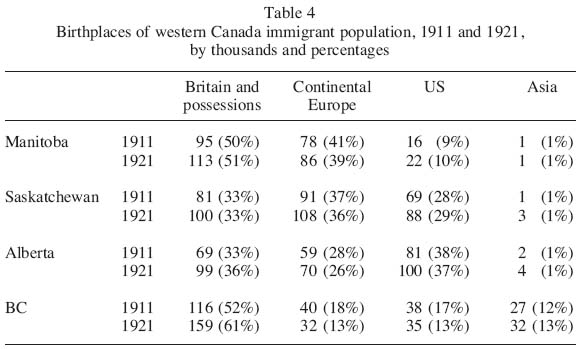
Display large image of Table 4
10 From this perspective, it is very easy to slip from the first into the second definition of regions as being defined in relationship to the capital. When we conceive of the centre, it is not as a visual extension of the place we call home. British Columbia's difficult terrain, although rich in the natural resources that have long sustained the economy, has encouraged a sense of alienation. Our location on the edge makes the capital sometimes seem very far away. It is easy to accept, as a matter of course, the maxim most often attributed to longtime premier W.A.C. Bennett that Vancouver is 3,000 miles from Ottawa, but Ottawa 30,000 miles from Vancouver. Repeatedly, we have felt misunderstood or not heard.
British Columbia as constructed by other regions
11 While BC's location and geography are distinctive, our human history, I have already suggested, is largely derivative. The critical exceptions are Aboriginal peoples, who are only recently recovering the prominence they once possessed. The lack of treaties has become, somewhat ironically, an important basis by which British Columbia's Aboriginal peoples have redefined themselves and thereby the region as distinctive.
12 Otherwise, it is outsiders who have constructed BC as a region, just as they have done to other regions of Canada. Immigrants from Great Britain, Asia and elsewhere have been fundamental to population growth, but so has migration from within Canada. Whatever the time period, fewer than half of non-Aboriginal British Columbians were, as Table 5 indicates, born in the region. One in 4 and, at some points as many as 1 in 3, have, since the completion of the transcontinental railway in the mid-1880s, been born elsewhere in Canada.
13 While proportions of migrants from within Canada have held steady over time, what has changed are the regions from which they come. In the late-19th century 1 in 6 non-Aboriginal British Columbians was born in Ontario and 1 in 12 in the Maritime Provinces (as Newfoundland and Labrador was not yet part of Canada). From the Great Depression onwards it was the Prairie region that contributed most to British Columbia's population growth. By the mid-20th century 1 in 5 British Columbians were born on the Prairies, a proportion that had fallen to 1 in 7 by 2001.
Table 5. Birthplaces of non-Aboriginal British Columbians born in Canada, by thousands and percentages
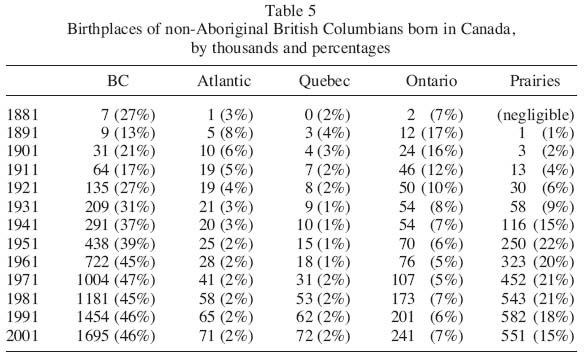
Display large image of Table 5
14 It was the Atlantic region that first got me rethinking regions relationally. By chance I came upon the correspondence of two Scottish Presbyterian sisters from rural Pictou County, Nova Scotia, who went west to teach shortly after the completion of the Canadian Pacific Railway in the mid-1880s. Jessie and Annie McQueen took the train almost outside their door and eight days later arrived at their destination in the British Columbia interior. The impetus to their doing so was a combination of Presbyterian zeal and economic necessity. A Presbyterian minister in Kamloops with ties to Pictou County wanted the children in his congregation to be inculcated with the same values he preached on Sundays. There were teaching jobs to be had near to his church, and the cash-poor McQueen family could not resist the promised $60 a month in wages each of their two youngest daughters could command compared with the $60 for half-a-year's teaching they had been receiving at home.
15 The more letters I read the more I realized that the McQueen sisters, both of whom spent much of their lives itinerating across British Columbia, were doing far more than earning a living. I ended up writing a book entitled Sojourning Sisters in which I argue for the important role women like Jessie and Annie played historically in terms of British Columbians becoming more Canadian in outlook.4 The sisters promoted in their everyday lives the values of hard work, fair play and respect that men like their Pictou County counterpart George Monro Grant were enunciating in the public domain as central to Canada as a nation. Grant firmly believed that Maritimers were the most influential Canadians in nation building. If referring to a somewhat later time period, historian Ian McKay concurs that "Atlantic Canadians have often been the most grounded, cogent and sustained Canadian nationalists".5 It was Grant's "Canadianism", McKay's fellow historian John Moir argues, "that marked him out as the most influential and vocal of those Maritime Presbyterians who held a national rather than an Ontario vision of Canada's destiny".6 The largely mundane character of most women's lives makes their contribution to nation building more difficult to detect than that of men except, as with Jessie and Annie, where an exceptional source of everyday knowledge survives.
16 The McQueen family correspondence, now available on the World Wide Web through the Atlantic Canada Virtual Archives (http://atlanticportal.hil.unb.ca/acva/en/mcqueen/ ) at the University of New Brunswick, is useful not just for disentangling the sisters' contribution to British Columbia, but for probing larger issues. Although the letters do not talk explicitly about the Maritimes as a region, the sisters clearly take it for granted. Jessie and Annie's older married sisters Mary Belle, Eliza and Dove made their lives respectively in Saint John, New Brunswick, Dartmouth, Nova Scotia, and as itinerants across the Maritimes, and their correspondence suggests that they all considered themselves part of a single, familiar region.
17 The correspondence also expands on the two youngest McQueen sisters' experiences in British Columbia. As Table 5 indicates, the proportion of the non-Aboriginal BC population born in the Maritimes reached its height just after the sisters' arrival. Even though the proportion was relatively small at 1 in 12, the letters attest that such persons played critical roles by virtue of their concentration in the key areas of education and the clergy. No occupations played more pivotal roles during these years, by virtue of possessing bases of authority external to their settings, than did teaching and preaching. The McQueen family correspondence describes the many ways that Maritimers helped to shape British Columbia, be it the considerable proportions of Presbyterian and Methodist ministers or the many teachers, school administrators and later University of British Columbia professors who nudged the region toward their points of view.
18 Recognition that regions construct each other is even more evident in British Columbia's interaction with the Prairie region. I became aware of its influence in writing a general history of British Columbia and had it reinforced through being invited to help celebrate Saskatchewan's centennial of entry into Confederation in 1905.7 As tables 3 and 5 in combination describe, the Depression and then the boom years of the mid-20th century drew thousands west from the Prairies; some of these had been born on the Prairies while others were earlier immigrants from continental Europe.
19 Whereas the impact of Atlantic Canada was initially strongest in the social and cultural realms, the Prairie region gave British Columbia a new political orientation. Many migrants brought with them a disposition towards – or at the least familiarity with – the political party in power in their old province. In Saskatchewan this was, beginning in 1944, the Co-operative Commonwealth Federation (CCF) while in neighbouring Alberta it was Social Credit. Not only did the CCF and later the New Democratic Party acquire broad appeal in British Columbia, but the populism that animated Social Credit moved west from Alberta. The vehicle for bringing the party to power in British Columbia was a New Brunswicker named W.A.C. Bennett, who moved to Alberta in 1919 at age 18 and then in 1930 to British Columbia. About to join the fledgling party in 1951, Bennett mused how "I am genuinely interested in Social Credit and believe that the Alberta Government has been outstanding in its accomplishment".8 For a full two decades (1952-1972), Bennett ruled British Columbia under the Social Credit banner. Not only that, three years later he was followed by his son, W.R. Bennett, who presided over the province, albeit more sedately, for another decade.
20 It was, in other words, a Maritime migrant seasoned on the Prairies, the senior Bennett, who so fiercely lamented the centre's inattention to British Columbia in his 3,000/30,000-miles-to-Ottawa comparison. In almost the same breath, his speeches juxtaposed such lines as "we believe in the Canadian dream, ocean to ocean" with "we're the only part of Canada that really could go it alone" as "the Dominion of British Columbia".9
21 The influence of the Prairies, like that of the Atlantic region earlier, has extended into every dimension of British Columbian life. Just as happened with Jessie and Annie McQueen's generation, British Columbians' religious orientation altered in ways consistent with the new arrivals. Conservative Protestant denominations – Baptist, Mennonite, Reformed, Pentecostal and various evangelical and fundamentalist groups – appealed to many of the same Prairie arrivals who embraced Social Credit. At the beginning of the Depression these denominations attracted just 4 to 5 of every 100 British Columbians, but by the 1970s they accounted for 7 to 8 out of every 100 residents.10
22 The Prairies continue to help make British Columbia as evidenced by the ongoing pride in track-and-field star Harry Jerome, whose statue overlooks Vancouver from a place of prominence in Stanley Park, the wide-ranging influence of businessman Jimmy Pattison, and the tragedy of Yvonne Boen, one of a large number of women for whose murder a Fraser Valley pig farmer has been charged. All three are from Saskatchewan. Then there's Manitoba-born Bob Hunter, remembered on his death in May 2005 as a founder of Greenpeace in Vancouver in 1970 and for his opposition to whale hunting.11 As these examples attest, many of the outlooks we attribute to British Columbia as a region – be it personalistic provincial politics, environmentalism, athletic prowess, edgy entrepreneurship or the murder of prostitutes – have Prairie ties. We in British Columbia are not nearly so autonomous as a region as we sometimes would have ourselves to be.
23 The third aspect of my rethinking other regions' influence on British Columbia is only now getting underway. For a long time I have been intrigued by what happened to the hundreds of men who came west from Quebec with the fur trade. Historian Allan Greer's speculation, in Peasant, Lord, and Merchant, that "most men involved in the fur trade were only temporarily absent" from Quebec seems too facile an explanation.12 In the course of ongoing research on Aboriginal women who during the 19th century had families with newcomer men, I have met numerous descendants who voice another history. A Social Sciences and Humanities Research Council-funded research project, in conjunction with fur trade historian Bruce Watson, probes the lives of Iroquois from the Montreal area and of French Canadians more generally in the Pacific Northwest to the end of the 19th century and perhaps through the mid-20th century.
24 Our sense at the project's beginning is that, despite the small numbers compared with migrants from other regions, both French Canadians and Iroquois made a difference. They were for the most part modest folk, living on the edge out of economic necessity but also to protect their families, often with local Aboriginal or mixed-race women, by keeping them out of public view. The racism long animating Canada made it expeditious for them to do so and thereby to disappear from the public record. Their actions do not, we surmise, diminish their contribution to the making of British Columbia as a region.
Re-imagining regions
25 The ways that migrants from Atlantic Canada, the Prairies, Quebec and, of course, Ontario have constructed British Columbia may echo for the development of other regions, but only somewhat given our exceptional population growth. Each region's geography and human history is distinctive. A brief look at three of the most basic classifiers – birthplace, language and religious affiliation – in the 2001 census gives a beginning point for re-imagining regions more generally.
26 The complexities inherent in as well as between regions are highlighted in Table 6, which compares birthplaces both among regions and internally within each region between the major city and the rest of the region. Overall, every region except for British Columbia is grounded in demographic continuity. Virtually two-thirds or more of residents in each region excepting British Columbia were, Table 6 shows, born in the province where they live. The Atlantic region and Quebec are the most stable with over 8 out of 10 so born. Table 6 also turns our attention to the argument sometimes made that regions are being replaced by urban areas as the principal points of distinction within Canada. Whatever the measure used, the Atlantic region and Quebec still have the most stable populations and British Columbia is the outlier.
27 It is in respect to immigrants, as opposed to migrants, that the major cities may be decoupling from their regions. The cities' appeal for arrivals from Europe ranges from 6 times as much as the rest of the region for Montreal to just over twice as much for Halifax and 1.5 times for Toronto and Calgary. The differential in respect to immigrants from Asia is far greater. The proportions of residents born in Asia range from 1 in 50 in Halifax to 1 in 20 in Montreal and 1 in 10 in Calgary, and then jump to 1 in 5 in Toronto and 1 in 4 in Vancouver. In contrast, in no region does the proportion of immigrants from Asia living outside the major city exceed 1 in 30.
Table 6. Birthplaces of Canadians, compared between region, major city, and rest of region, 2001
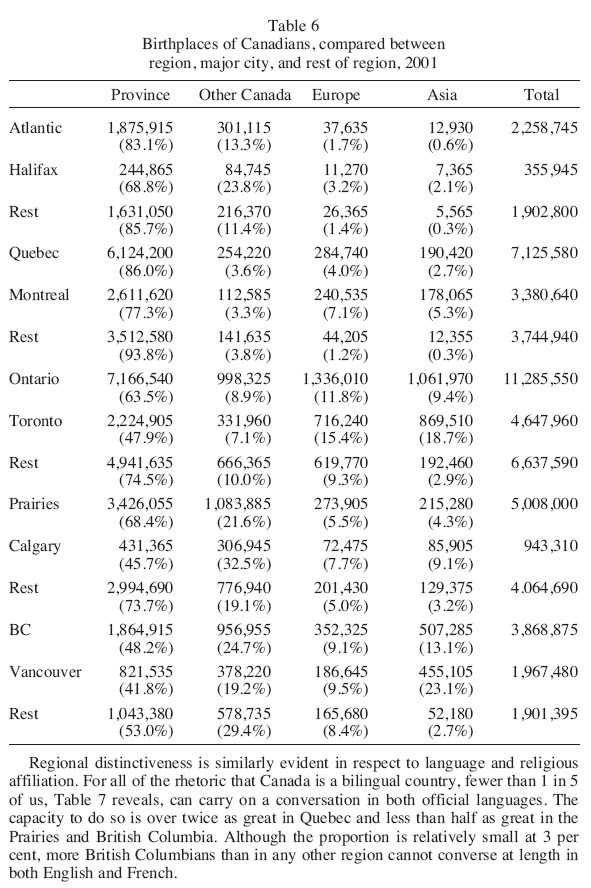
Display large image of Table 6
28 Regional distinctiveness is similarly evident in respect to language and religious affiliation. For all of the rhetoric that Canada is a bilingual country, fewer than 1 in 5 of us, Table 7 reveals, can carry on a conversation in both official languages. The capacity to do so is over twice as great in Quebec and less than half as great in the Prairies and British Columbia. Although the proportion is relatively small at 3 per cent, more British Columbians than in any other region cannot converse at length in both English and French.
Table 7. Ability to carry on a conversation of some length in Canada's official languages, 2001
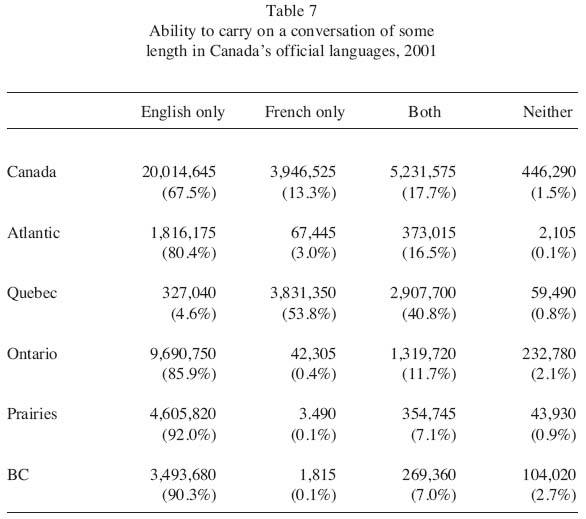
Display large image of Table 7
29 Table 8 reveals some unexpected differences in respect to religious affiliation. Overall in Canada, 2 out of 5 of us are Roman Catholics, but it is not the denomination's predominance in Quebec, as might be expected, that is responsible. Catholicism is the principal religion of affiliation in every region of Canada. Conversely, the two denominations associated historically with English Canada – United/Presbyterianism and Anglicanism – engage relatively small minorities in every region. The largest is in the Atlantic region at 1 in 3 while the lowest, apart from Quebec, is in British Columbia at 1 in 5 or 6.
30 British Columbia is once again an outlier. Consistent with the region's appeal to immigrants from Asia, 1 in 12 British Columbians are Buddhists, Hindus, Muslims or Sikhs. As for the established Christian religions, Anglicanism is the only faith to hold its own, likely due to the region's lingering British ethos. Far fewer British Columbians are Catholic than in any other region and there are fewer members of the United or Presbyterian churches than in any other region except for Quebec. More than 1 in 3 of British Columbians have no religious affiliation whatsoever, compared with 1 in 5 on the Prairies.
Table 8. Principal religious affiliations of Canadians, 2001
A British Columbian view of regions
31 A British Columbian view of regions, as I have pointed out through various demographic measures, is complex and to some extent contradictory. Since Confederation British Columbia has grown faster than any other region through a combination of migration and immigration. Atlantic Canadians, Prairie folk and Quebeckers have, among others, helped to form the region we know as British Columbia.
32 Perhaps it is our geography and location, but, despite all the newcomers from elsewhere in Canada and from around the world, we remain distinctive from whence they came. "It's like a different country out here" is how a recently arrived southern Ontarian put it to me.13 Or, as a visitor from Ireland summed up, "I love being here, BC is just wicked!"14 We need, clearly, to look more closely at, among other issues, the motives drawing Canadians west. I am reminded of one of novelist Margaret Atwood's protagonists, for whom British Columbia was "as far away from Toronto as I could get without drowning".15
33 Our perceptions of regions in relationship to each other depend, of course, on the regional position of our viewing. Whatever our perspective, each of the regions has much to teach its counterparts, as with Quebeckers' far greater willingness than residents of any other region to become bilingual. And then there are our differing attitudes toward religious affiliation. Among the most critical areas benefiting from a greater exchange between regions, but not specifically examined here, are the economy, the environment and reconciliation with Aboriginal peoples.
34 To argue that regions have constructed each other is not then to deny the real differences between them. It is, however, to suggest that we in Canada may spend too much time defining ourselves in competition with each other or with the centre and not enough time reflecting on how we can learn from each other.16 We end up frustrated with no real gain. By shifting our gaze, we acquire a fuller sense of what it is that has united, and continues to hold together, this country called Canada.
JEAN BARMAN
University of British Columbia
Notes
